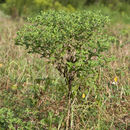Description
provided by eFloras
Plants 10–60+ cm. Stems erect. Leaf blades rhombic-ovate to obovate, (20–)40–120(–150+) mm, faces finely pilosulous, gland-dotted. Fruits ± compressed, ± cuneate to obovate, 4–6+ mm, not notably ribbed, terminal spines 2, divergent, 3–4 mm, often 1 ± uncinate, prickles seldom notably uncinate, ± scattered. 2n = 22.
- license
- cc-by-nc-sa-3.0
- copyright
- Missouri Botanical Garden, 4344 Shaw Boulevard, St. Louis, MO, 63110 USA
Distribution
provided by eFloras
Native of Brazil; introduced weed in parts of Africa and S.Asia.
- license
- cc-by-nc-sa-3.0
- copyright
- Missouri Botanical Garden, 4344 Shaw Boulevard, St. Louis, MO, 63110 USA
Elevation Range
provided by eFloras
500-1100 m
- license
- cc-by-nc-sa-3.0
- copyright
- Missouri Botanical Garden, 4344 Shaw Boulevard, St. Louis, MO, 63110 USA
Derivation of specific name
provided by Flora of Zimbabwe
hispidum: hispid, bristly
- license
- cc-by-nc
- copyright
- Mark Hyde, Bart Wursten and Petra Ballings
- bibliographic citation
- Hyde, M.A., Wursten, B.T. and Ballings, P. (2002-2014). Acanthospermum hispidum DC. Flora of Zimbabwe website. Accessed 28 August 2014 at http://www.zimbabweflora.co.zw/speciesdata/species.php?species_id=160280
- author
- Mark Hyde
- author
- Bart Wursten
- author
- Petra Ballings
Description
provided by Flora of Zimbabwe
Erect annual much-branched subshrub, up to 60 cm. Stems covered in coarse white hairs. Leaves opposite, oblong-lanceolate, sessile; margin variously entire or toothed. Inflorescences axillary or terminal with minute creamy-yellow flowers. Fruits spiny with 2 long spines at the apex, arranged in star-shaped groups of 7 or 8.
- license
- cc-by-nc
- copyright
- Mark Hyde, Bart Wursten and Petra Ballings
- bibliographic citation
- Hyde, M.A., Wursten, B.T. and Ballings, P. (2002-2014). Acanthospermum hispidum DC. Flora of Zimbabwe website. Accessed 28 August 2014 at http://www.zimbabweflora.co.zw/speciesdata/species.php?species_id=160280
- author
- Mark Hyde
- author
- Bart Wursten
- author
- Petra Ballings
Frequency
provided by Flora of Zimbabwe
Common
- license
- cc-by-nc
- copyright
- Mark Hyde, Bart Wursten and Petra Ballings
- bibliographic citation
- Hyde, M.A., Wursten, B.T. and Ballings, P. (2002-2014). Acanthospermum hispidum DC. Flora of Zimbabwe website. Accessed 28 August 2014 at http://www.zimbabweflora.co.zw/speciesdata/species.php?species_id=160280
- author
- Mark Hyde
- author
- Bart Wursten
- author
- Petra Ballings
Worldwide distribution
provided by Flora of Zimbabwe
Native to South America, now a pan-tropical weed.
- license
- cc-by-nc
- copyright
- Mark Hyde, Bart Wursten and Petra Ballings
- bibliographic citation
- Hyde, M.A., Wursten, B.T. and Ballings, P. (2002-2014). Acanthospermum hispidum DC. Flora of Zimbabwe website. Accessed 28 August 2014 at http://www.zimbabweflora.co.zw/speciesdata/species.php?species_id=160280
- author
- Mark Hyde
- author
- Bart Wursten
- author
- Petra Ballings
Acanthospermum hispidum
provided by wikipedia EN
Acanthospermum hispidum (bristly starbur, goat's head, hispid starburr, starbur) is an annual plant in the family Asteraceae, which is native to Central and South America.[1][2][3] This plant is cited as a weed in cotton culture in Brazil, and it is also used as a medicinal plant. It is also naturalized in many scattered places in Eurasia, Africa, and North America[4][5][6][7] It is naturalized in Australia and is a declared weed in Western Australia.[8]
References
-
^ Berendsohn, W.G.; Araniva de González, A.E. (1989). "Listado básico de la Flora Salvadorensis: Dicotyledonae, Sympetalae (pro parte): Labiatae, Bignoniaceae, Acanthaceae, Pedaliaceae, Martyniaceae, Gesneriaceae, Compositae". Cuscatlania. 1 (3): 290:1–290:13.
-
^ Cabrera, A.L. (1978). "Compositae". In Cabrera, A.L. (ed.). Flora de la provincia de Jujuy. Vol. 10. Buenos Aires: Instituto Nacional de Tecnología Agropecuaria. pp. 1–726.
-
^ Serrano, M.; Terán, J. (1998). Identific. Esp. Veg. Chuquisaca. Sucre: PLAFOR, Intercooperación, Fundación Ceibo. pp. 1–129.
-
^ "Acanthospermum hispidum de Candolle". Flora of North America. Vol. 21. p. 37.
-
^ "刺苞果 ci bao guo Acanthospermum hispidum". Flora of China. Vol. 20–21. p. 865.
-
^ Wild, H (1967). "The Compositae of the Flora Zambesiaca area, 1". Kirkia. 6 (1): 1–62.
-
^ Humbert, H. (1941). "Contributions a l'etude de la flore de Madagascar et des Comores (fascicule 2)". Notul. Syst. Paris. 9: 95–111.
-
^ "Australian Weed Profile: Acanthospermum hispidum". profiles.ala.org.au. Retrieved 2020-07-31.

- license
- cc-by-sa-3.0
- copyright
- Wikipedia authors and editors
Acanthospermum hispidum: Brief Summary
provided by wikipedia EN
Acanthospermum hispidum (bristly starbur, goat's head, hispid starburr, starbur) is an annual plant in the family Asteraceae, which is native to Central and South America. This plant is cited as a weed in cotton culture in Brazil, and it is also used as a medicinal plant. It is also naturalized in many scattered places in Eurasia, Africa, and North America It is naturalized in Australia and is a declared weed in Western Australia.
- license
- cc-by-sa-3.0
- copyright
- Wikipedia authors and editors

